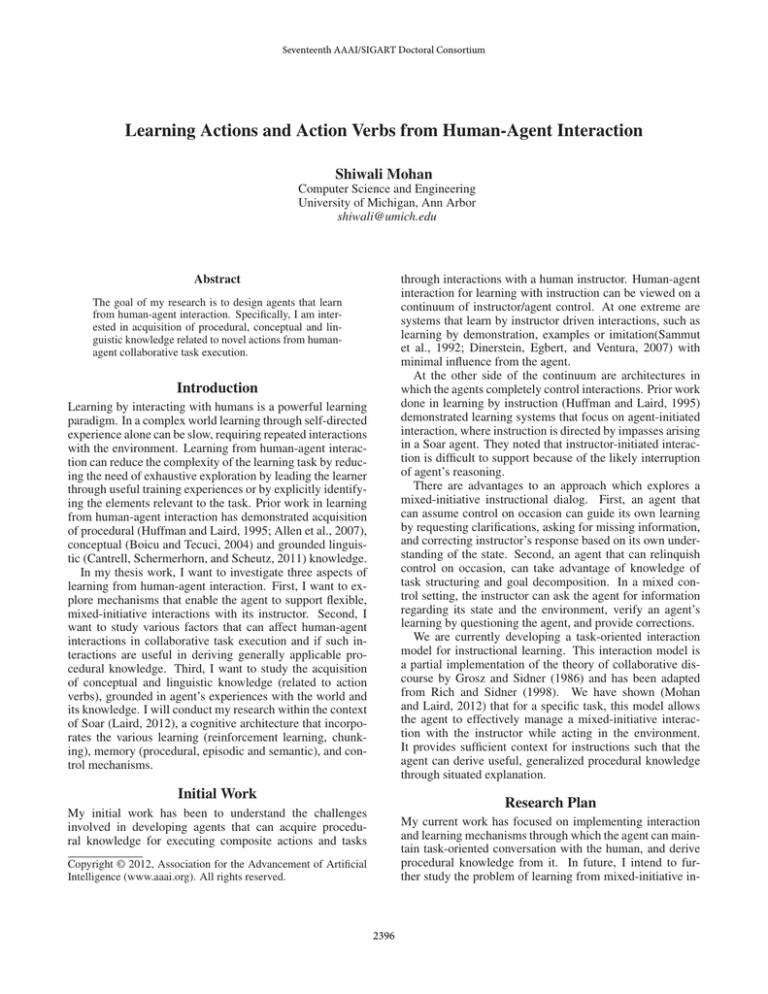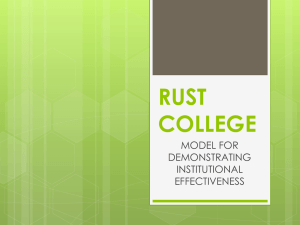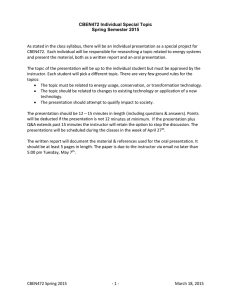
Seventeenth AAAI/SIGART Doctoral Consortium
Learning Actions and Action Verbs from Human-Agent Interaction
Shiwali Mohan
Computer Science and Engineering
University of Michigan, Ann Arbor
shiwali@umich.edu
Abstract
through interactions with a human instructor. Human-agent
interaction for learning with instruction can be viewed on a
continuum of instructor/agent control. At one extreme are
systems that learn by instructor driven interactions, such as
learning by demonstration, examples or imitation(Sammut
et al., 1992; Dinerstein, Egbert, and Ventura, 2007) with
minimal influence from the agent.
At the other side of the continuum are architectures in
which the agents completely control interactions. Prior work
done in learning by instruction (Huffman and Laird, 1995)
demonstrated learning systems that focus on agent-initiated
interaction, where instruction is directed by impasses arising
in a Soar agent. They noted that instructor-initiated interaction is difficult to support because of the likely interruption
of agent’s reasoning.
There are advantages to an approach which explores a
mixed-initiative instructional dialog. First, an agent that
can assume control on occasion can guide its own learning
by requesting clarifications, asking for missing information,
and correcting instructor’s response based on its own understanding of the state. Second, an agent that can relinquish
control on occasion, can take advantage of knowledge of
task structuring and goal decomposition. In a mixed control setting, the instructor can ask the agent for information
regarding its state and the environment, verify an agent’s
learning by questioning the agent, and provide corrections.
We are currently developing a task-oriented interaction
model for instructional learning. This interaction model is
a partial implementation of the theory of collaborative discourse by Grosz and Sidner (1986) and has been adapted
from Rich and Sidner (1998). We have shown (Mohan
and Laird, 2012) that for a specific task, this model allows
the agent to effectively manage a mixed-initiative interaction with the instructor while acting in the environment.
It provides sufficient context for instructions such that the
agent can derive useful, generalized procedural knowledge
through situated explanation.
The goal of my research is to design agents that learn
from human-agent interaction. Specifically, I am interested in acquisition of procedural, conceptual and linguistic knowledge related to novel actions from humanagent collaborative task execution.
Introduction
Learning by interacting with humans is a powerful learning
paradigm. In a complex world learning through self-directed
experience alone can be slow, requiring repeated interactions
with the environment. Learning from human-agent interaction can reduce the complexity of the learning task by reducing the need of exhaustive exploration by leading the learner
through useful training experiences or by explicitly identifying the elements relevant to the task. Prior work in learning
from human-agent interaction has demonstrated acquisition
of procedural (Huffman and Laird, 1995; Allen et al., 2007),
conceptual (Boicu and Tecuci, 2004) and grounded linguistic (Cantrell, Schermerhorn, and Scheutz, 2011) knowledge.
In my thesis work, I want to investigate three aspects of
learning from human-agent interaction. First, I want to explore mechanisms that enable the agent to support flexible,
mixed-initiative interactions with its instructor. Second, I
want to study various factors that can affect human-agent
interactions in collaborative task execution and if such interactions are useful in deriving generally applicable procedural knowledge. Third, I want to study the acquisition
of conceptual and linguistic knowledge (related to action
verbs), grounded in agent’s experiences with the world and
its knowledge. I will conduct my research within the context
of Soar (Laird, 2012), a cognitive architecture that incorporates the various learning (reinforcement learning, chunking), memory (procedural, episodic and semantic), and control mechanisms.
Initial Work
Research Plan
My initial work has been to understand the challenges
involved in developing agents that can acquire procedural knowledge for executing composite actions and tasks
My current work has focused on implementing interaction
and learning mechanisms through which the agent can maintain task-oriented conversation with the human, and derive
procedural knowledge from it. In future, I intend to further study the problem of learning from mixed-initiative in-
Copyright © 2012, Association for the Advancement of Artificial
Intelligence (www.aaai.org). All rights reserved.
2396
representation of verb meaning would on one hand link to
perception and control of action in the physical environment,
and on the other provide structural hooks for the argument
structure of verbs (Roy, 2005). It would also allow for relating similar verbs and associating affordances with objects.
Recent efforts to model grounded language acquisition
have focused on models that ground the meaning of verbs
in motor control structures (Feldman and Narayanan, 2004)
and perceived movements of objects (Siskind, 2001). However, such systems constrain the human-agent interactions
to labeling of action sequences. I am interested in exploring
if explicit interactions with human instructors about various
aspects of verbs combined with reasoning about its experiences with the environment would allow the agent to build
rich, grounded representation of action verbs.
struction and extend learning mechanisms to allow the agent
to acquire grounded representations of action verbs along
with procedural knowledge associated with corresponding
actions.
Mixed-Initiative Interaction
Walker and Whittaker (1995) characterize human communication as mixed-initiative, bi-directional flow of information. Conversational partners not only respond to what others say, but volunteer information, and ask questions. Initiative in an interaction can be understood as the control over
what and how information is transferred among the participants of that interaction.
The transfer of information for successful human-agent
collaborative action is influenced by various characteristics
of the environment and the state of agent’s knowledge. An
agent that begins in a novel environment with very limited
knowledge will need to communicate with a human expert
about the environment to so that it can act and learn. If the
environment is partially observable to either the agent, the
human or both, bi-directional transfer of information is essential for reasonable action. Human-agent interaction in
such scenarios needs to be mixed-initiative, in which both
the human instructor and the agent can introduce topics in
conversation.
I want to study various factors that influence initiative
in interactions between a human instructor and a learning
agent. Such understanding is essential for implementing an
interaction model using which the agent can maintain and
learn from a task-oriented, mixed-initiative interaction with
a human instructor.
Dinerstein, J.; Egbert, P. K.; and Ventura, D. 2007. Learning Policies for Embodied Virtual Agents Through Demonstration. In In
Proceedings of International Joint Conference on Artificial Intelligence.
Learning Actions
Feldman, J., and Narayanan, S. 2004. Embodied Meaning in a
Neural Theory of Language. Brain and language 89(2):385–92.
References
Allen, J.; Chambers, N.; Ferguson, G.; and Galescu, L. 2007. Plow:
A Collaborative Task Learning Agent. In Proceedings of the National Conference on Artificial Intelligence.
Boicu, C., and Tecuci, G. 2004. Mixed-Initiative Ontology Learning. In Proceedings of the 2004 International Conference on Artificial Intelligence.
Cantrell, R.; Schermerhorn, P.; and Scheutz, M. 2011. Learning Actions from Human-Robot Dialogues. In Proceedings of the
IEEE Symposium on Robot and Human Interactive Communication, 125–130.
Grosz, B., and Sidner, C. 1986. Attention, Intentions, and the
Structure of Discourse. Computational linguistics 12(3):175–204.
Learning actions involves acquiring the following knowledge; applicability conditions, knowledge of conditions under which the action can be applied; execution, knowledge
of how the state (of the environment and agent) changes as
an action is applied and termination conditions, knowledge
of the goal of an action. An agent that learns novel actions
by interacting with a human instructor should be able to derive such knowledge from its interactions and observations
from the environment.
Prior work (Huffman and Laird, 1995) has shown that
such knowledge can be derived from an instructed example
execution of a novel action and explicit interactions about its
applicability and termination conditions. However, in situations where the state of the agent is not completely observable by the human instructor, such explicit interactions are
impossible. The agent must derive applicability and termination conditions of the action from multiple executions. I
want to investigate if a complete history of multiple executions of an action and related state changes (available from
episodic memory) captures the information required to derive applicability and termination conditions.
Huffman, S., and Laird, J. 1995. Flexibly Instructable Agents.
Journal of Artificial Intelligence Research 3.
Laird, J. E. 2012. The Soar Cognitive Architecture. MIT Press.
Mohan, S., and Laird, J. E. 2012. Exploring Mixed Initiative Interaction for Learning with Instruction in Cognitive Agents. In
Twenty-Sixth Conference on Artificial Intelligence (AAAI Student
Abstract).
Rich, C., and Sidner, C. 1998. COLLAGEN: A Collaboration
Manager for Software Interface Agents. User Modeling and UserAdapted Interaction 8(3):315–350.
Roy, D. 2005. Connecting language to the world. Artificial Intelligence (June).
Sammut, C.; Hurst, S.; Kedzier, D.; and Michie, D. 1992. Learning
to Fly. In Proceedings of the Ninth International Workshop on
Machine Learning.
Siskind, J. 2001. Grounding the Lexical Semantics of Verbs in
Visual Perception using Force Dynamics and Event Logic. Journal
of Artificial Intelligence Research 15:31–90.
Walker, M., and Whittaker, S. 1995. Mixed Initiative in Dialogue:
An Investigation into Discourse Segmentation. In Proc 28th Annual Meeting of the ACL, 8. Association for Computational Linguistics.
Learning Action Verbs
Beyond simply labeling sequences of movement, verbs often encode causal and temporal structure. An ideal grounded
2397


